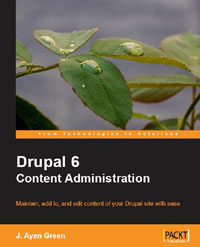Book Review: Drupal 6 Content Administration
 Anyone who's tried to explain Drupal's content feature-set to the uninitiated appreciates the amount of territory that needs covering as well as the challenges inherent in presentation depth and order. J. Ayen Green takes up the challenge in his book, Drupal 6 Content Administration, published by Packt Publishing. Packt graciously provided me a copy for review.
Anyone who's tried to explain Drupal's content feature-set to the uninitiated appreciates the amount of territory that needs covering as well as the challenges inherent in presentation depth and order. J. Ayen Green takes up the challenge in his book, Drupal 6 Content Administration, published by Packt Publishing. Packt graciously provided me a copy for review.
The stated purpose of Drupal 6 Content Administration is "a quick-start guide that best serves Drupal Content Editors." Green is serious about the audience and serious about the content focus. The discussion and examples are firmly rooted on content and live in the user interface, using language targeted to the audience; except for the appendix, there are no digressions into unrelated topics like site administration, SEO, or account management.
The book's content falls into three broad categories: authoring/formatting content, methods for displaying content, and managing content. Each subject has a short introduction and explanation, and almost all include an example of something that can be implemented with step-by-step instructions for doing so. Green has made an interesting decision, the step-by-step instructions assume the Drupal site has already been configured and he does not digress into a discussion on configuring the modules required for the example.
Drupal 6 Content Administration succeeds in its goal and is the closest thing I've seen to a manual for content maintainers. At 180 pages, this book is focused on the tasks presented. The concepts are given concrete form by examples, which are demonstrated with detailed implementation steps. Further, the examples are pragmatic. For example, in the area of authoring Green doesn't tell the reader to rely solely on the editor, but walks them through switching back and forth from HTML to the editor (something that most advanced users of my acquaintance do) and he discusses embedding images and other media content types. There is also a discussion of pasting content from MS Word. Beyond content authoring, the reader is given a solid introduction to the mechanics of content in Drupal, covering roles, permissions, CCK, Views and taxonomy. There's even a discussion of using BlogAPI tools (with a Windows Live Writer example) and email gateways for content input.
I do have some quibbles. Web developers will find a slightly non-standard use of terms (when someone says "rich content type", a block isn't the first thing that comes to mind). While I applaud addressing the audience using minimal Drupal jargon I'm concerned they'll be tripped up if and when they become better read on Drupal (or general web development). I would have liked a better up front description of the Drupal site configuration used for the book's example activities. Someone with no Drupal resources to fall back on would have a steep learning curve getting a site in place if they wanted to do the examples as they read the book. There is an appendix on installing Drupal, but it's easily missed. A reference to the Aquia DAMP stack might be a nice work-around. Finally, I would have liked a stronger list of outside references for readers who wanted to go further.
Drupal 6 Content Administration is exactly what it says it is, a quick-start guide on Drupal content for those working with content. If that's what you're looking for definitely give it a look. The full table of contents is available online: Drupal 6 Content Administration Table of Contents, as is Chapter 5: Making Content Findable in Drupal 6.
